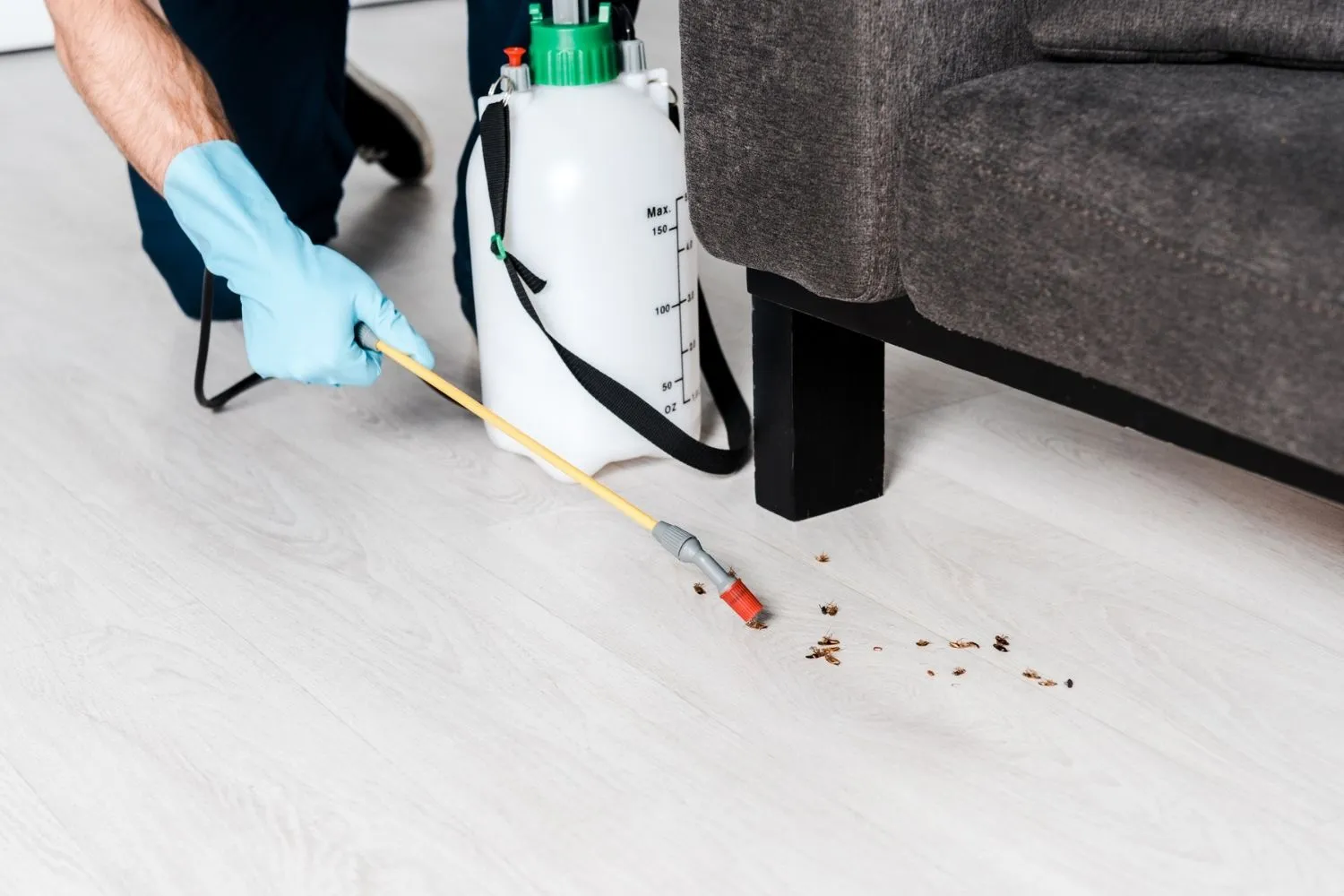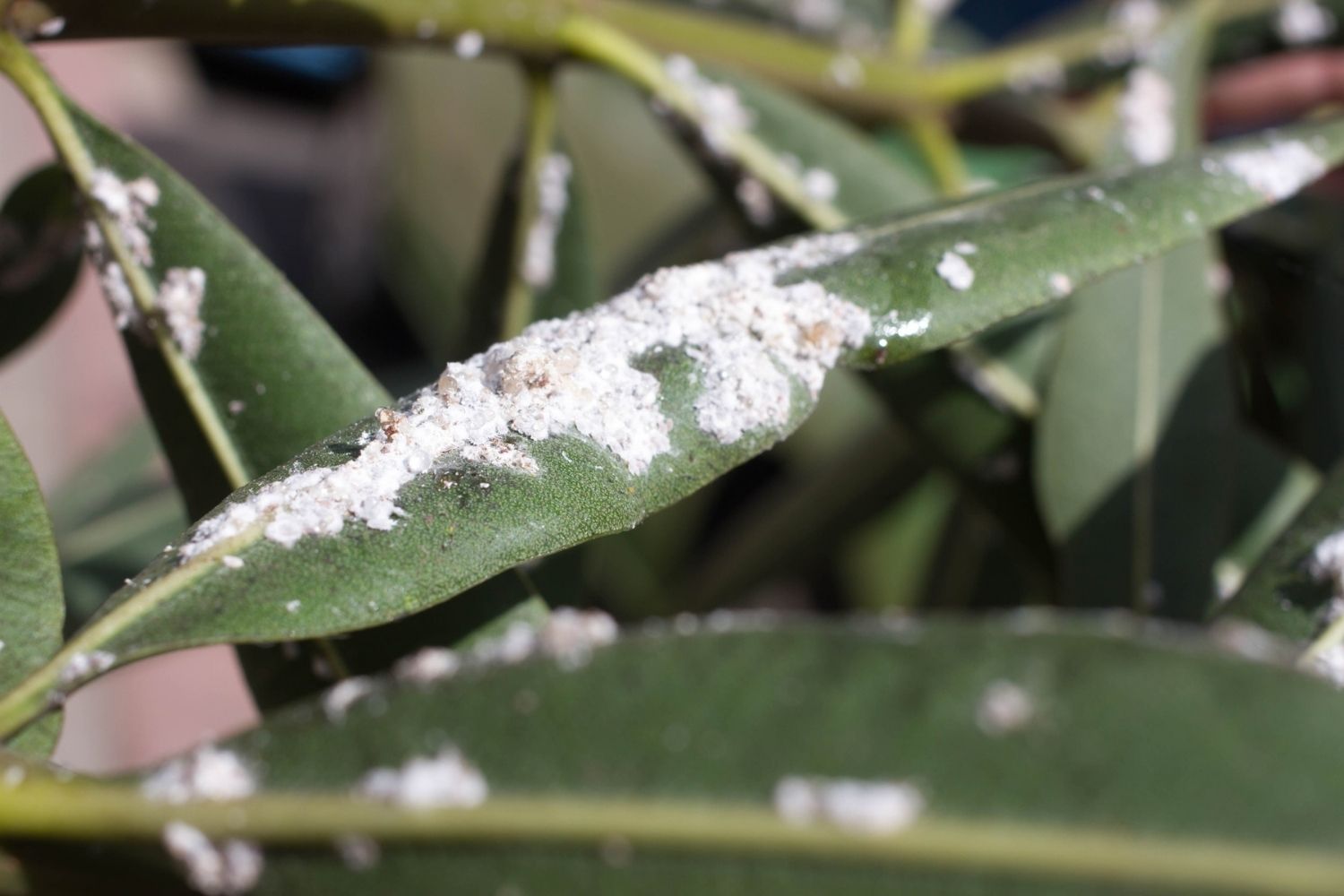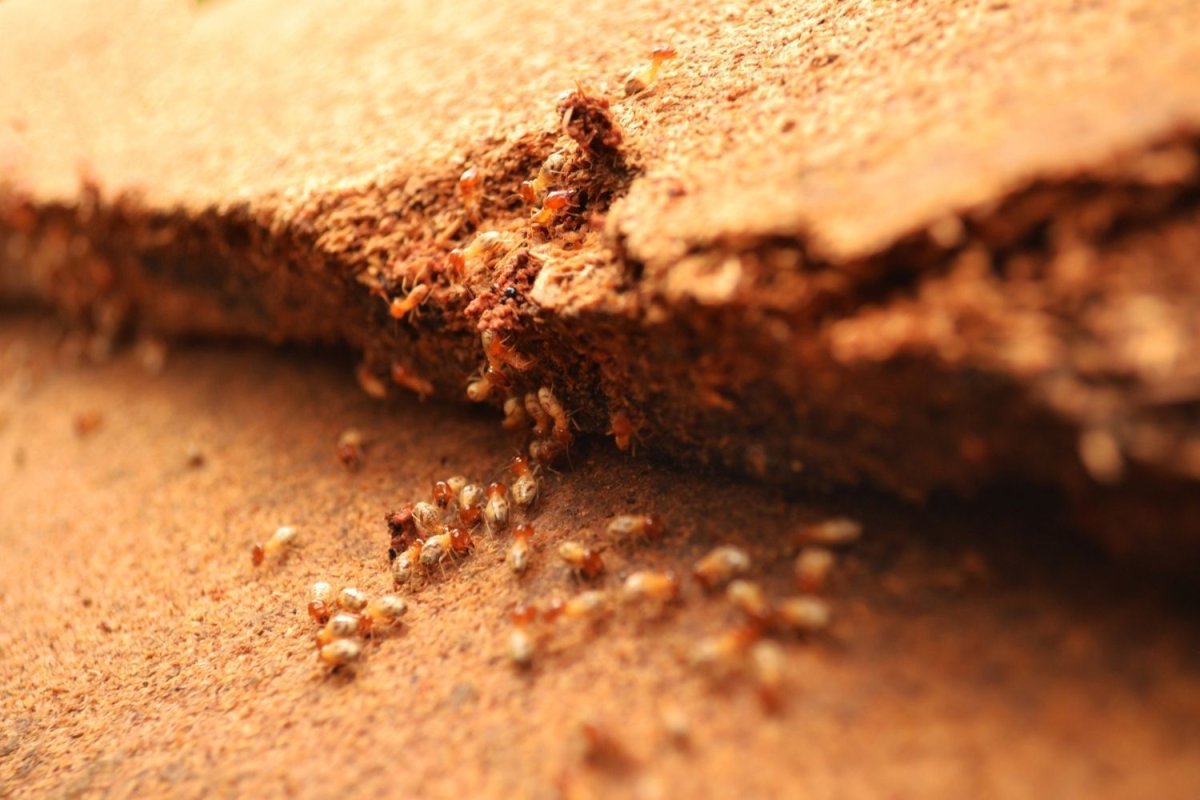We may earn revenue from the products available on this page and participate in affiliate programs. Learn More ›
Q: I just noticed a bunch of tiny white bugs inside my home. How can I tell what kind of bugs they are, and how can I get rid of them in a way that ensures they don’t return?
A: Although small in size, tiny white bugs inside the home can cause more harm than you’d think if the infestation is severe. In the worst-case scenario, termites have taken over, and a homeowner will need professional treatment. In the best-case scenario, you’ve got some pesky insects feeding on clothing fibers, plants, or food in your pantry, and you’ll need to take a closer look to identify which type of tiny white bug has made its way inside. The steps below will help you figure out what bug you’ve spotted as well as tips on how to get rid bugs in the house such as termites, whiteflies, carpet beetles, aphids, or booklice. We’ll also help you determine when to call in a professional and how you can prevent tiny white bugs from returning to your home.
Tiny white bugs may be termites, and they require professional treatment.
If a homeowner or renter spots tiny white bugs on drywall, wooden floorboards, windowsills, wooden doors, or anywhere else in the home that’s made of wood, they may be dealing with termites. While some termites are brown, drywood or subterranean worker termites are lighter in color. These bugs typically live within their colonies inside wooden structures and are hard to spot. If termites are coming out into the open, it could signal that the colony is growing even larger. White bugs don’t automatically mean termites, though. Residents will want to inspect any areas where bugs were spotted for hollow-sounding wood, pinpoint holes, squeaking, stuck windows or doors, piles of wings, or small mounds of sawdust. Subterranean termites, one of the lighter-colored varieties, may also create mud tubes around a home’s foundation.
Other signs of termites include discolored or drooping drywall, peeling paint, squeaky floorboards, buckling laminate flooring, or maze-like patterns in wood. If a resident sees any of these signs along with the presence of tiny white bugs, it’s time for them to call in a specialist. Termites can cause serious damage to a home and threaten its structural integrity if the issue is ignored for long enough. Termites are also notoriously difficult to get rid of, and it’s not recommended that a homeowner try to tackle termites on their own.
If the home does have termites, an exterminator will be able to assess the amount of damage they have done and determine where the colony lives. These tiny white bugs can nest in gutters and pipes, so a professional is a resident’s best bet at finding and getting rid of them in those hard-to-reach or dangerous areas. Plus, several solutions used to get rid of termites contain harmful ingredients that may be hazardous to household members. A professional will protect themselves and the home using tools and personal protective equipment that a homeowner may not be able to access. Once measures have been put in place to get rid of the termites, the resident will need to consult a restoration expert to begin the process of repairing the damage and making sure the home is no longer vulnerable to future infestation.
There are some ways a resident can prevent termite infestation in the first place. First, they’ll want to store any wood piles away from the house, as this creates an accessible food source for termites coupled with easy access to the home. Subterranean termites gravitate toward moisture, so fixing any drainage issues or pooling water around the foundation can discourage them from settling. Wood mulch makes a home’s landscape look nice but again, it’s an easy food source for termites. If the home has had termite issues in the past, the resident will want to keep wood mulch raked back away from the house or consider an alternative mulch like rubber chips. An experienced termite professional can also make regular trips to the home to apply termite treatment.
Tiny white bugs around clothing may be clothes moths.
If a homeowner or renter has spotted tiny white bugs skulking around the sweaters in the back of your closet, they’re likely seeing clothes moths. Also known as webbing clothes moths, these insects feed on natural fibers found in clothes, such as wool and cashmere. These insects are about ⅜-inch long and range in color from cream to light yellow. They have elongated bodies with thin, long wings and tiny legs. Clothes moths aren’t a threat to humans, as they don’t bite, sting, or contaminate food sources. But they could do some severe damage to a resident’s wardrobe.
When dealing with clothes moths, it’s essential for the resident to act fast at the first sign of infestation, as they can wreak havoc on clothing that is either irreplaceable or expensive to replace. Once the tiny white bugs have been identified, the homeowner or renter will want to inspect the clothing to see what, if any, damage has been done. They may want to repair any small holes and then dry clean any items they keep to ensure any moth larvae are killed. Other items can be washed at home in hot water, but residents will want to read labels beforehand to prevent shrinkage. It’s also important to dispose of any items with extensive, irreparable damage.
Next, it’s advised for residents to vacuum the closet (and deep clean carpet, if applicable) to eliminate any remaining eggs and larvae. If the infestation is particularly severe or is present in multiple spaces of the house, the resident may want to consider a professional cleaning service. To avoid further infestation or discourage clothes moths from returning, residents will want to store items of clothing made from natural fibers in containers with lids to ensure they’re safe, and make sure they launder any items before storing them away for an extended period. Finally, they’ll want to brush off any winter coats and jackets outside to remove any larvae or eggs.
Sachets of dried lavender or planks of cedar made for hanging in a closet are also easy hacks to deter clothes moths—plus, they’ll leave behind a pleasant scent. Lavender and cedar are best used in combination, as cedar can kill clothes-moth larvae and lavender will repel grown moths. (And while they’re not tiny white bugs, these methods should help residents get rid of carpet beetles, which also feast on natural-fiber knitwear, or prevent them from coming into the closet in the first place.)

Psocids (also known as booklice) prefer dark, moist places.
If a resident sees tiny white bugs inside food packages, on wallpaper, or in books, they’re likely dealing with booklice (otherwise known as psocids). Psocids aren’t actually lice, and they’re also known as barklice or barkflies. Booklice are pesky but mostly harmless bugs that prefer dark, damp places. Psocids feed on decaying organic material and are common in humid climates or poorly ventilated homes. A resident may find psocids on or near damp cardboard boxes, books, papers, wood, and leaking sinks. Psocids are also common in new construction homes since they can come in on construction materials used to build the house. Once the humidity in the home subsides, these tiny bugs will likely go away on their own.
At 1/25- to 1/13-inch long, they can be hard to spot with the naked eye. The most damage they’ll do is destroy some bindings in books. These bugs do not have wings and cannot fly, so they’re pretty easy to get rid of once they’re spotted. However, the presence of booklice can signal a more extensive mold or moisture issue that should be addressed. Because booklice feed on molds, eliminating their food source will keep them from returning to the inhabited space. If the home has small mold patches, the resident will want to clean infested areas with borax, vinegar, or enzyme-based substances. Also, residents will want to be sure to increase ventilation and reduce humidity in the home. They can contact a mold remediation specialist if they have large areas of mold, if mold spreads through more than one room, or if they have respiratory or immune issues that make them susceptible to mold illness.
Grain mites are most likely to be found in the kitchen.
Grain mites are small white or gray insects. As their name suggests, they feed on processed grains like flour and cereals as well as cheese, wheat germ, and yeast. It’s possible grain mites found their way indoors through packaged foods. The white mites reproduce rapidly in warm and humid conditions. Even if a resident only sees a few in a bag of flour, they’ll want to inspect food items in their pantry and in all of their cabinets, and dispose of any contaminated food.
Since no chemical solutions exist to eliminate grain mites, thoroughly cleaning the space they inhabit is a resident’s best bet for removing them. On flat surfaces, residents can use a hot, soapy rag to clean the area. A vacuum cleaner with an attachment for small crevices can reach tight corners or hard-to-clean areas where grain mites may settle. Keeping dry goods in tightly sealed containers will prevent grain mites from returning.
Prevention is the best cure for removing these bugs and ensuring they don’t return. When shopping for pantry items, residents will want to carefully look at items, and avoid bringing damaged packages or containers that look damp into the home. They’ll want to keep any dry goods secured in airtight containers, and ensure that their food storage area can get appropriate ventilation and isn’t too crowded. If the kitchen suffers from too much humidity, the resident may want to consider investing in a dehumidifier. This will have the added bonus of reducing the risk of psocids, as well as mold and mildew.

Mealybugs and whiteflies can infest and damage plants.
If a resident sees white bugs on plants, it could mean the beauties they’ve spent precious time growing are in danger. One whitefly may not be a threat, but several whiteflies can infest and damage a home’s plants. Although they are most commonly discovered outdoors, whiteflies can find their way indoors through infested plants. Whiteflies may seem small and harmless, but they can excrete a sticky substance that makes them difficult to control. Mealybugs, which are related to whiteflies, are oval-shaped and also excrete a sticky substance.
Mealybugs feed on new growth and suck the juice from host plants, often causing leaves to be yellow and drop from the plant. They can cause fruits, vegetables, and flower buds to drop prematurely, ruining weeks and months of hard work. If the mealybug infestation is nasty, their excretions can encourage the growth of sooty mold fungus. They can infest a wide range of plants but prefer tropical species and plants with high nitrogen levels. This is particularly true for plants that have been overfertilized or overwatered.
If a resident is wondering how to get rid of whiteflies and mealybugs, they’ll first want to inspect any plants before bringing them indoors, and place any infested plants back outside. Another tip for getting rid of mealybugs is to use a homemade plant spray made of garlic, onion, cayenne pepper, and dish soap. This solution can be poured into a spray bottle and used on indoor plants where the mealybugs are present. A resident can then store the spray bottle in the refrigerator for 1 week until a new solution is made. Other ways to prevent mealybugs from infesting plants are to reduce feeding and watering, wipe foliage regularly, spray plants with hard blasts of water, and drop nighttime temperatures. These efforts can help eliminate the tiny white bugs without damaging a resident’s precious plants in the process.
If a homeowner or renter is not certain about the type of tiny white bugs they’re seeing in their home, one of the best pest control companies (like Orkin or Terminix) can help identify the type of bug they have and eradicate the critters using correct and more permanent methods. Finally, professionals can offer advice on how to prevent further issues.


